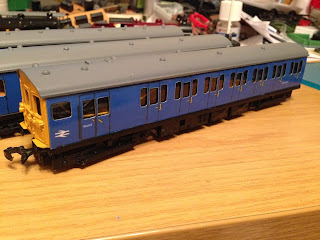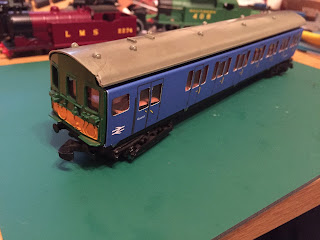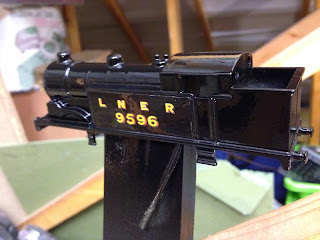Now that the background graphics have been tweaked, they can be inserted into the design.
Of all the Microsoft applications, I use Powerpoint the most and find it the most familiar to create the designs and then use Publisher to create the final graphic for printing.
First wagon style - St Ivel / Unigate.
These exist in a later, plastic form and I own one of these already, it just doesn't run that well and looks out of place, also doesn't have the right couplings and is extremely light. First thought was to scan the body and just copy the image but the resolution and quality just wasn't good enough, so I went back and re-did this design from scratch.
After Googling the logos, the Unigate one was found and at a good enough resolution to copy and paste straight into the design. Handily their logo hasn't changed since these wagons were produced.
The same can't be said for St Ivel, no trace of the old logo above anywhere, just this modern version which has a narrower outer band and the extra blue rectangular background.
First thought was to crop the image and enlarge but it didn't look right. Thankfully the image resolution of the Unigate loco is much higher and I was able to grab the colour from the blue St Ivel logo and flood-fill the red Unigate one. The lettering was then brushed out and the St Ivel lettering copied and pasted into the new logo. The resolution of the lettering is much lower but for use on an OO gauge wagon it's fine. The difference in resolutions can be seen below:
It was then a matter of placing the two logos onto the wagon graphics, centre everything and print onto self-adhesive paper.
The roofs of the wagons were stripped, primed in Halfords grey primer and lacquered.
The final result:
The result is quite a reasonable interpretation of the original design.
Now for something different - Zanussi.
Some artistic licence required for this one, although they've been around since well before the demise of Hornby Dublo, the livery I'm using is actually from the 1980s.
I worked for Zanussi and proudly drove around in a fully liveried van many years ago. The livery itself, though basic, was very effective and quite striking. It didn't survive for long and by the mid 90s it was almost extinct. There are very few examples of the old livery left.
This had to be completely re-created from scratch, so I found a PDF of an old washing machine instruction booklet, this gave me the basic fundamental parts of the livery I needed...
At first glance, this looked ok but on closer analysis, the bottom of the planet has been cropped.
Using MS Paint again, I grabbed the right hand section of the planet ring, flipped it and attached it to the opposite end...
The planet logo was then coloured yellow using flood fill, the Zanussi lettering, after being sharpened first, had the same treatment.
Finally for the livery I was looking to re-create, I needed the yellow stripe at the bottom. This was created using the autoshapes, it's just a yellow rectangle with a black circle, sized the same as the planet, layered over the top. The planet graphic is then superimposed on top to create this fairly accurate interpretation:
Printed and cut to size, my graphics are designed as wrap-around, ie there is only one seam, it just means that they're a little more tricky to align.
Shiny repainted roof, this one's ready to join the fleet...
My third design was a brewery wagon. As a Dorchester lad, I wanted some local companies and I was aware that Dapol had produced an Eldridge, Pope wagon. I wasn't a huge fan of it and decided use a bit of artistic licence again!
Eldridge, Pope are sadly no longer in existence, this again means that it's difficult finding logos and graphics on the internet. Thankfully I found a high resolution scan of two EP beer mats, after using the same processes to tweak the images as the previous wagons, I had the two most famous EP logos shrunk down to size.
Now for the lettering. Not easy!
The O of Co and the TD of Ltd are usually displayed in Superscript with the full stop underneath.
I spent many hours trawling through font styles to replicate this look before realising that I could actually use any of the fonts in MS office and use the Superscript function. HOWEVER, I also wanted the lettering to appear in an arc, this means using Wordart, and Wordart doesn't accommodate Superscript. To make this work, the Wordart was copied into Paint, the O and TD were cut, shrunk and pasted back into place, with the full stops being moved.
The green colour scheme I've used is nothing like the Dapol version. EP used many different shades of green over the years, I quite liked this shade.
Finally, the three scrap wagons after restoration:
I've now created 9 new wagons using these designs, I'll probably do some more with the eventual aim of having a whole goods train made up of modified wagons.


























































